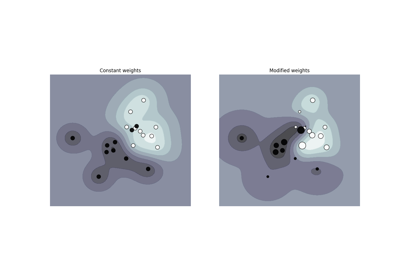Note
Go to the end to download the full example code. or to run this example in your browser via Binder
最近邻回归#
演示使用k-最近邻解决回归问题,并使用重心和常数权重对目标进行插值。
# 作者:scikit-learn 开发者
# SPDX-License-Identifier: BSD-3-Clause
生成示例数据#
import matplotlib.pyplot as plt
import numpy as np
from sklearn import neighbors
np.random.seed(0)
X = np.sort(5 * np.random.rand(40, 1), axis=0)
T = np.linspace(0, 5, 500)[:, np.newaxis]
y = np.sin(X).ravel()
# 添加噪声到目标
y[::5] += 1 * (0.5 - np.random.rand(8))
拟合回归模型#
n_neighbors = 5
for i, weights in enumerate(["uniform", "distance"]):
knn = neighbors.KNeighborsRegressor(n_neighbors, weights=weights)
y_ = knn.fit(X, y).predict(T)
plt.subplot(2, 1, i + 1)
plt.scatter(X, y, color="darkorange", label="data")
plt.plot(T, y_, color="navy", label="prediction")
plt.axis("tight")
plt.legend()
plt.title("KNeighborsRegressor (k = %i, weights = '%s')" % (n_neighbors, weights))
plt.tight_layout()
plt.show()

Total running time of the script: (0 minutes 0.091 seconds)
Related examples





